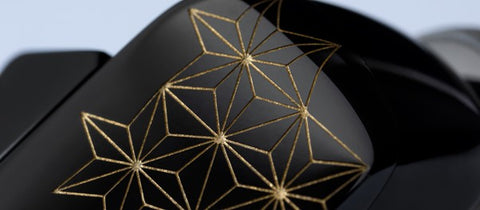Wajima: Japan's Urushi Capital
A Japanese word meaning sunken gold, Chinkin is used to describe a Japanese craft in which carved patterns are inlaid with a mixture of gold powder and resin.
Today, we take you to the heart of the action in Wajima, Japan's Lacquer capital -- And the birthplace of the spidery gold Asanoha lines that make the SHICHIKU.KANGEN the hand-crafted treasure it is.
What Makes Wajima Japan's Lacquer Capital ?

There's probably nowhere else as blessed as Wajima when it comes to fulfilling the prerequisites needed for the production of lacquerware: To the point that lacquerware coming out of Wajima has its own name. Wajima-nuri.
For starters Wajima is a forested region rich in both resin-producing trees and the Noto Cyprus forming the base of most Japanese lacquerware. making it the Urushi (Lacquer) capital of Japan since olden days.
Wajima does not only produce high-quality natural lacquer, it also has a humid continential climate, providing the ideal climatic conditions for the urushi hardening process.
Curiously, unlike most substances that dry best when moisture is pulled out of it. Urushi is a finicky substance a dries best in a humid environment at a specific temperature: Ideally 70 – 85% humidity in temperatures of 24°C to 28°C. The lacquer hardens as it absorbs oxygen from the moisture in the air.
Chinkin and Japanese Lacquerware
Japanese lacquerware "shikki" 漆器 refers to items decoratively covered with lacquer (Urush 漆) . A living breathing art form unique to Japan. This can include things like bento boxes, utensils, and, more recently, pens and earphones.
Dating as back to the neolithic and paleolithic ages, lacquer techniques were found to have been used in Japan as early as the prehistoric Jomon period (14,000–300 BCE) where ocher and cinnabar were used alongside black lacquer to produce different tones and effects.
Chinkin is a branch of Urushi art, where beautiful patterns emerge when gold sinks into the lacquer which has been applied into the carved groove, maximising the brilliance and ensuring the long-lastingness of the gold designs.
The key to maximizing the brilliance of the pure gold is the finest natural lacquer, tapped from Japanese forests.
Wajima Lacquerware
Designated a traditional craft by the government of Japan, Wajima lacquerware is produced in the area around Ishikawa Prefecture’s Wajima City. A fixture of the city and its culture, Wajima lacquer can be found on the streets, a major, early example being the torii gate of Shigezo Shrine, built in 1397. Making the SHICHIKU.KANGEN part of a a legacy that's nearly 600 years old.
Wajima's craftspeople create their lacquerware by hand in an extremely complex procedure spanning as many as 124 individual processes altogether. Sometimes with individual craftspeople who specializing in each step in the production.

The process can largely be divided into three key steps, however: preparing the base wood, painting the base with lacquer, and decorating the lacquered form with either chinkin or maki-e.
Living the history of Chinkin and Shikki in Wajima
With travel quite impossible in the current global climate, we've curated a list of lacquerware destinations in Wajima you can put a pin in if you should be lucky enough to visit the area in the future!
A different Morning Market:

The Wajima Morning Market (Source)
One of the three biggest morning markets in Japan, Wajima's morning market is open on it's asaichi-dori (literally: Morning market street) daily between 8:00 and 12:00, lined with vendors selling various goods, including fresh seafood and produce.
Also on sale at the morning market is Wajima's famed lacquerware, with numerous lacquerware merchants lining either side of the market: These make good souvenirs for their beauty and durability, and also the fact that a pair of chopsticks and a small plate won't be taking up too much of your baggage allowance.
Wajima Nuri Kaikan, a feast of the eyes:

Wajima Nuri Kaikan (Source)
The best of Wajima's lacquerware is showcased within the Wajima Lacquer hall (Wajima Nuri Kaikan) which has been designated a national tangible cultural property of Japan and features more 3800 pieces both by master craftsmen of the past and contemporary artists. Included pieces that have been recognised by the Japanese government as tangible cultural heritage.
Tickets are available to adults from 300 yen, not much more than a deli sandwich, making it a wonderful cultural destination for the thrifty backpacker.
The Wajima Museum of Lacquer (Urushi) Art

This museum focuses on the larger Wajima-Nuri culture, offering insight into the process and history that lie behind Wajima lacquerware with thorough explanations of the entire process and its intricacies.
Chinkin, Wajima and SHICHIKU.KANGEN
A joint labour of love between final Audio and DITA Audio's Japanese and Singapore offices. Each SHICHIKU.KANGEN unit has passed through the hands of a craftsman in Wajima, where gold is inlaid within the Asanoha pattern carved on its chassis.
More than a pair of earphones, the SHICHIKU.KANGEN is part of the Urushi Legacy. A celebration of the wonderful things that can happen when sound, soul and the human touch meet.
